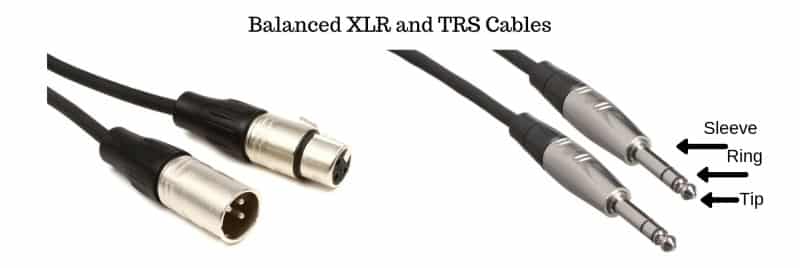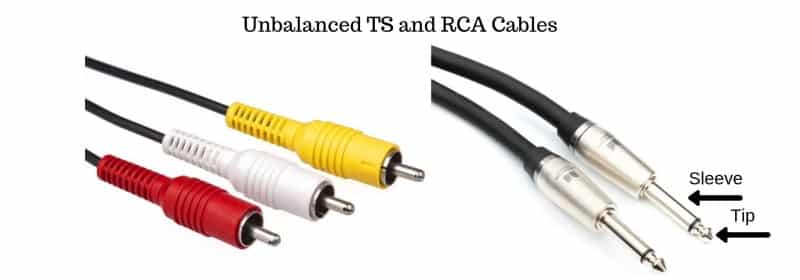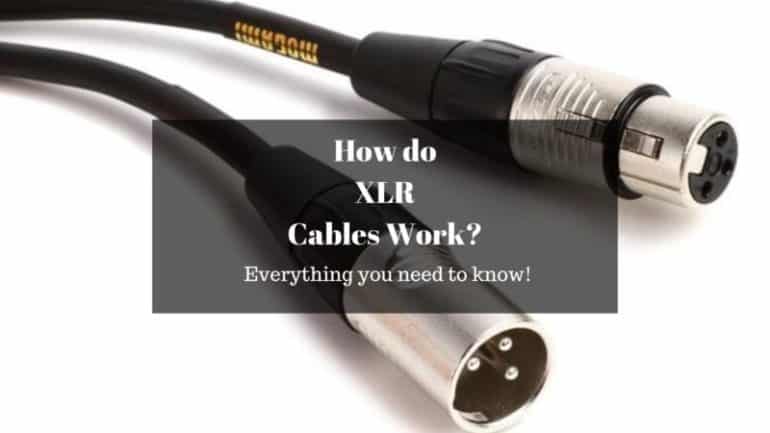Last updated on May 17th, 2021 at 07:38 am
XLR cables are an essential component of every home- and even professional- studio.
But have you even wondered why this is?
In this article I will do my best to explain how they work, the difference between balanced and unbalanced cables, if they can carry power, and more.
How does an XLR Cable Work?
XLR Cables deliver a balanced audio signal, which means that any interference picked up by the cable will be “filtered out”, reducing the overall noise level. This works because the audio signal is being carried by the positive and the negative wires which have opposite polarities.
Once the signal reaches the end of the cable the polarities are re-inverted which cancels out, or phases out, any external interference picked up by the cable.
Let me explain this with more detail…
Imagine you’re the audio engineer at a live show and you need to connect every mic to your mixing board…
These cables are usually pretty long, meaning that they are way more susceptible to picking up any unwanted noises/interferences than short cables, right?
Here’s where XLR cables come in handy!
XLR cables are fantastic at reducing interference because when audio is fed into them, the negative wire inverts the signal.
What happens now is that the positive and the negative signals are travelling along the cable, but they are completely out of phase with each other…
If we leave them like this then no sound will be heard, simply because it’s the exact same two waveforms which are being inverted.
Why is this useful?
Well, think of it this way; Since the cable is so long the chances of it picking up any unwanted noises and interference are pretty high…
But these noise signals aren’t out of phase with each other like our original audio signals are…
What this means is that when the signal is inverted back at the receiving gear, so that the positive and the negative are no longer cancelling each other out, the noise in the negative wire gets inverted.
Now the original audio signal is IN PHASE while the noise that was picked up is now OUT of PHASE, effectively cancelling out any noises that might have been picked up.
This way you get a clean audio signal without any, or almost any, unwanted noises.
Difference between Balanced and Unbalanced cables
I just mentioned that XLR cables carry a balanced signal…
So, what’s the difference then between a balanced and an unbalanced cable then?
Balanced Cable

Balanced cables have three wires in them; Two signal wires and a ground wire.
Balanced cables work like I just explained a bit earlier…
The source is split into two identical signals and is inverted in the negative wire which means that now the audio signal in cancelled out.
Once the signal reaches the receiving gear it will be flipped back into its original orientation meaning that it’s no longer being cancelled/out of phase.
Outside interference will now be cancelled out thanks to that last polarity flip providing a very clean audio signal.
The typical Balanced audio cables that we tend to use are; “XLR” and “TRS” (Tip-Ring-Sleeve) cables.
Unbalanced Cable

Unbalanced cables are fairly simple…
They consist of two wires which serve as conductors; One carries the audio signal and other one the ground.
You can quickly tell balanced and unbalanced cables apart because of how many conductors the cable has.
You might be familiar with the typical unbalanced cables, or “TS” (tip-sleeve) cables, like the ones used with electric guitars or basses…
Or if you look behind any typical home audio system, you’ll find some RCA connectors on the back… These are also unbalanced cables.
The issue with unbalanced cables is that they pick up a lot more unwanted noise.
This isn’t a big issue if you’re using a short cable, but I wouldn’t recommend using one that’s over 25 meters long.
In this case your best bet would be to go with a balanced one, like XLR or TRS.
Does an XLR Cable carry Power?
XLR cables can carry phantom power which is used to power condenser microphones and other equipment.
The most common type of XLR cable has 3 pins.
Pins 2 and 3, which are the ones that carry the audio signal, can also carry the phantom power voltage.
This means that if the supplied power is 48v, like it usually is, then Pin 2 will be 48v, Pin 3 will be 48v and Pin 1 will be grounded.
Related: If you’re looking for a high-quality Audio Interface that provides phantom power then make sure to read this post I wrote.
Some other XLR cables, like the ones that feature 7 pins instead of the traditional 3, are designed to power specific types of microphones, like the ones that have tubes in them.
This 7-pin XLR cable connects on the one side to the microphone and on the other to the power supply which can then feed the required power to the mic.
7-pin cables are not as commonly used though.
XLR Mic cable vs XLR speaker cable
Both cables use XLR connectors, but when taking a look inside, they are completely different.
Speaker XLR connectors are now being replaced by more modern hookups, like the SpeakOn connection…
But since a lot of the older equipment is still being used, it’s important to know the difference between these two cables.
Microphone XLR Cable
An XLR cable designed for microphone usage is the one I described in the beginning.
It’s a balanced audio cable that can be used for all microphone or line level applications such as connecting the mic to a mixer or audio interface, etc.
It is a relatively thin cable which has two conductor wires plus a shielded ground wire with a three-pin XLR connection and is protected from outside interference thanks to the braided shield.
The wires inside a mic XLR cable have a pretty small gauge which means that they can only withstand low voltage levels like the one needed to power a condenser mic (phantom power).
Speaker XLR Cable
A speaker XLR cable is used between an amp and a passive speaker.
Speaker cables are unshielded two-conductor wires (positive and negative), meaning that it’s not a balanced connection, which connect an amplifier speaker output to the speaker input jacks.
These cables are designed to carry higher current, which is why they have thicker gauge wires in them and are also heavier.
Another difference is that they don’t provide any shielding from outside interference.
Can they be interchanged?
Not really… The only time that it’s acceptable to use a mic XLR cable with a speaker is if powered speakers are used.
This is because if it’s a passive speaker then it will require a lot more current which the mic XLR cable can’t handle.
Also, active speakers have built-in amplifiers and are considered line-level devices for which every standard XLR cable is suitable.
Why they shouldn’t be interchanged
The most important reason is because in both cases using speaker cables to connect a mic, or vise versa, you can damage your gear.
But there are some other things that could happen as well;
If you use speaker cables with a mic, since they aren’t shielded you will probably get some hum and interference.
They even might not work at all…
If you use mic cables to power a speaker then, since speakers require higher voltage, you might get a low volume output.
Again, the most important reason is to avoid damaging the equipment.
Conclusion
Balanced XLR cables play a hugely important role.
They are essential when trying to eliminate unwanted noises during live shows and even in the studio.
The great thing is that they aren’t even expensive… This one that you can find on Amazon is super cheap and works perfectly.
Just like I mentioned earlier, it’s not completely necessary to use XLR cables if you’re using short cables…
However, if the cable you require is 20 meters or longer, do yourself a favor and use an XLR one.
I hope you found this information useful…
Have a wonderful day!

readers need recommendations for good gear, especially cables. thanks.